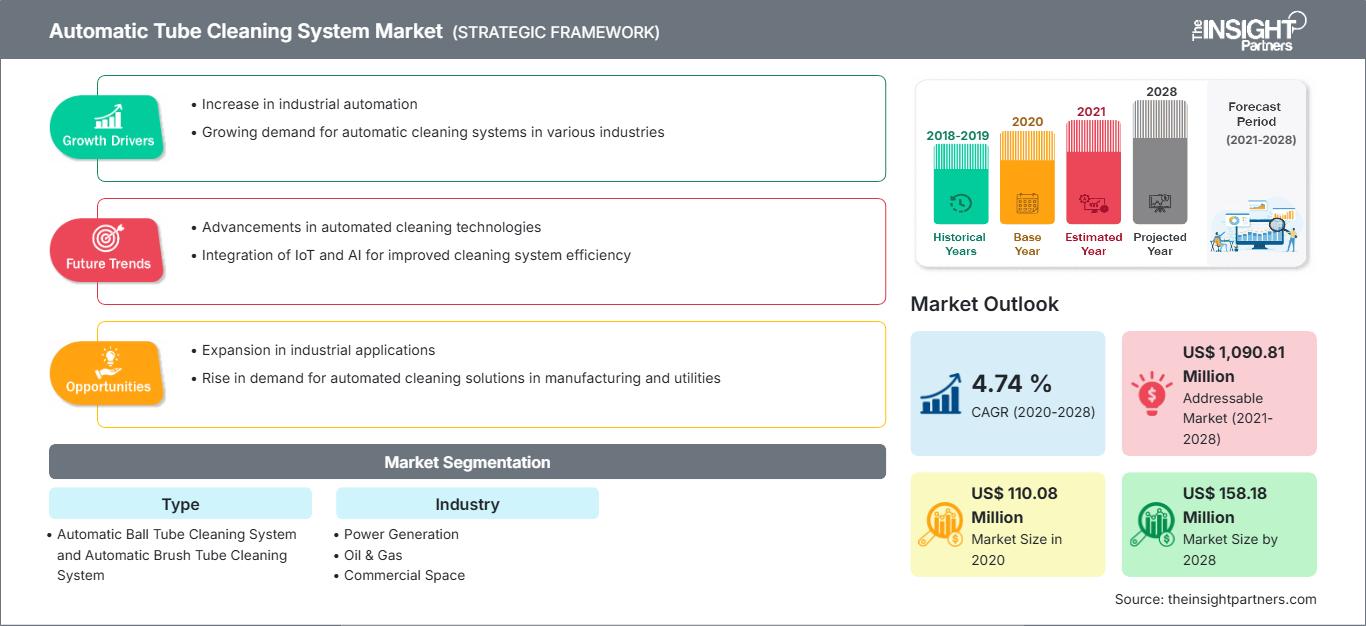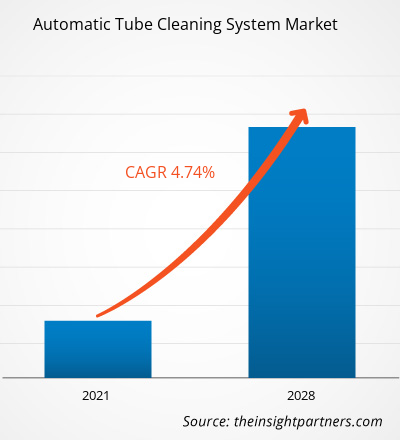[Forschungsbericht]Der Markt für automatische Rohrreinigungssysteme wurde im Jahr 2020 auf 110,08 Millionen US-Dollar geschätzt und soll bis 2028 158,18 Millionen US-Dollar erreichen; von 2021 bis 2028 wird ein CAGR-Wachstum von 4,74 % erwartet.
Ein automatisches Rohrreinigungsgerät besteht aus einem Reinigungskörper, der sich durch das Rohr bewegt und Ablagerungen von der Rohrwand entfernt. Im einfachsten Fall handelt es sich dabei um eine Bürste oder Kugel, die von einer Stange oder einer Flüssigkeitsfeder in das Rohr geschoben wird. In der Großtechnologie und im Industriesektor haben sich jedoch viele Mechanismen herausgebildet, die eine umfassendere Beschreibung erfordern. Automatische Rohrreinigungssysteme verbessern die Betriebsleistung von HLK-Systemen, was das Wachstum des Marktes für automatische Rohrreinigungssysteme vorantreibt. Das mangelnde Wissen über die beeindruckenden Vorteile automatisierter Rohrreinigungssysteme und die Möglichkeit der Fehlererkennung in einigen Systemen hemmen jedoch das Marktwachstum. Darüber hinaus dürfte die steigende Zahl künftiger Entsalzungsanlagenprojekte dem Markt in den kommenden Jahren lukrative Wachstumsaussichten eröffnen.
Darüber hinaus starten Regierungsbehörden neue Initiativen zur effizienteren Nutzung von Energie. So erließ die indische Regierung beispielsweise am 27. Mai 2007 den Energy Conservation Building Code (ECBC) für neue Gewerbegebäude. Der ECBC legte Mindestenergiestandards für neue Gewerbegebäude mit einer Anschlussleistung von 100 kW oder einem Leistungsbedarf von 120 kVA oder mehr fest. Obwohl der EC Act 2001 die Zentralregierung ermächtigt, können die Landesregierungen den Code an lokale oder regionale Bedürfnisse anpassen und die Öffentlichkeit darüber informieren. Diese Faktoren ermöglichen es Gebäudeeigentümern, ihre elektrischen Systeme regelmäßig zu überprüfen, was zu einer erhöhten Nachfrage nach automatischen Rohrreinigungssystemen führt.
Gewerbeflächen und Raffinerien arbeiten derzeit an der Nutzung energieeffizienter Verfahren. In naher Zukunft dürfte die Notwendigkeit, Kohlekraftwerke zu retten, das Wachstum des Marktes für automatische Rohrreinigungssysteme vorantreiben. Darüber hinaus wird die Rohrreinigung in der Medizin- und Gesundheitsbranche sowie in der Lebensmittelindustrie erwartet.
Der Markt für automatisierte Rohrreinigungssysteme im asiatisch-pazifischen Raum wird im Prognosejahr aufgrund von Infrastruktur- und Wirtschaftswachstum voraussichtlich ein erhebliches Wachstum verzeichnen. Dieser Bereich ist vielversprechend für automatisierte Rohrreinigungssysteme. Der wachsende Bedarf an Energieeinsparungen und verbesserter Betriebseffizienz in Raffinerien und Gewerbeflächen treibt die Nachfrage nach automatischen Rohrreinigungssystemen in der Region Asien-Pazifik an. In den kommenden Jahren wird der steigende Strombedarf aufgrund des verbesserten Wirtschaftswachstums zum Bau weiterer Kraftwerke führen, was voraussichtlich die Nachfrage nach automatisierten Rohrreinigungssystemen in der Stromerzeugungsbranche ankurbeln wird.
Passen Sie diesen Bericht Ihren Anforderungen an
Sie erhalten kostenlos Anpassungen an jedem Bericht, einschließlich Teilen dieses Berichts oder einer Analyse auf Länderebene, eines Excel-Datenpakets sowie tolle Angebote und Rabatte für Start-ups und Universitäten.
Markt für automatische Rohrreinigungssysteme: Strategische Einblicke

-
Holen Sie sich die wichtigsten Markttrends aus diesem Bericht.Dieses KOSTENLOSE Beispiel umfasst Datenanalysen, die von Markttrends bis hin zu Schätzungen und Prognosen reichen.
Die COVID-19-Pandemie hat Länder weltweit negativ beeinflusst. Um die Übertragung des neuartigen Coronavirus, das COVID-19 verursacht, zu verhindern, haben die Regierungen vieler Länder nationale Ausgangssperren verhängt. Die Menschen dürfen ihre Häuser nicht verlassen und sind nicht in der Lage, an ihren Arbeitsplatz zu gehen. Um ihre finanziellen Aktivitäten während der Epidemie aufrechtzuerhalten, sind Unternehmen weltweit von traditionellen auf Online-Module umgestiegen. Durch die Einführung von Online-Modulen gehen weniger Menschen an ihren Arbeitsplatz, was zu weniger funktionierenden HLK-Systemen und weniger Wartung führt. Infolgedessen wird inmitten der Pandemie die Einführung der automatischen Rohrreinigung behindert.
Markteinblicke: Zunehmender Einsatz automatischer Rohrreinigungssysteme in der Raffinerieindustrie
Viele Prozesse in Ölraffinerien leiden unter starker Verschmutzung, die die Gesamteffizienz und Rentabilität der Anlage beeinträchtigt. Höhere Brennstoffkosten, erhöhte CO2-Emissionen des befeuerten Erhitzers, erhöhte Pumpleistung sowie reduzierter Durchsatz und Leistungsfähigkeit der verarbeiteten Produkte sind allesamt übliche Betriebskosten, die mit der Verschmutzung von Wärmetauschern in Raffinerien einhergehen. Die Verschmutzung von Rohöl- und Produktströmen in Ölraffinerien ist ein unvermeidbares Problem mit schwerwiegenden wirtschaftlichen, ökologischen und sicherheitsrelevanten Folgen. Verschmutzung war schon immer ein Problem in Vorwärmstraßennetzen von Raffinerien, da sie zu geringerem Durchsatz, höherem Energieverbrauch und häufigeren Abschaltungen führte. Die Kosten für Rohölverschmutzung in Vorwärmstraßen betragen schätzungsweise 0,25 % des gesamten raffinierten Rohöls oder 66 Millionen Barrel pro Jahr. Aus diesem Grund bieten ATCS-Hersteller Raffinerien ein anpassbares automatisches Rohrreinigungssystem an, um Verschmutzungen von ihren Maschinen zu entfernen. So bietet Innovas Technologies, LLC eine integrierte Lösung zur Steigerung der Effizienz des Kühlprozesses in Raffinerien. Die Helios Tube Cleaning System-Technologie von Innovas Technologies verhindert Verschmutzungen in Prozesswärmetauschern auf natürliche und nachhaltige Weise, ohne teure Prozessabschaltungen oder chemische Behandlungen. Folglich trägt der Einsatz eines ATCS dazu bei, die Stromproduktion um 0,5 % zu steigern.
Die Verschmutzung von Wärmetauschern hat erhebliche Auswirkungen auf die Rentabilität von Raffinerien. Die größte Auswirkung auf den Gewinn entsteht, wenn die Produktionskapazität durch Verschmutzung beeinträchtigt wird. Unter solchen Umständen können die Gewinne um bis zu 17 % sinken. Daher erfreut sich der Markt in Raffinerien auf der ganzen Welt zunehmender Beliebtheit, mit mehr als 160 Einheiten in Prozessen mit hoher Verschmutzung wie Fluid Catalytic Cracking, Verkokung, Entsalzung und Abwasserbehandlung. Diese Faktoren werden voraussichtlich die Nachfrage nach automatischen Rohrreinigungssystemen beeinflussen.
Typbasierte Markteinblicke
Basierend auf dem Typ ist der globale Markt für automatische Rohrreinigungssysteme in automatische Kugelrohrreinigungssysteme und automatische Bürstenrohrreinigungssysteme unterteilt. Das automatische Kugelrohrreinigungssystem hatte im Jahr 2020 einen größeren Marktanteil und wird im Prognosezeitraum voraussichtlich eine durchschnittliche jährliche Wachstumsrate von 5,01 % verzeichnen. Der Markt für dieses Segment wächst aufgrund der einfachen Installation und Sammlung von Schwammbällen während der Wartung.
Branchenbasierte Markteinblicke
Der globale Markt für automatische Rohrreinigungssysteme ist branchenbezogen in die Bereiche Stromerzeugung, Öl und Gas, Gewerbeflächen, Gastgewerbe und Sonstige unterteilt. Im Jahr 2020 hatte das Segment Gewerbeflächen den größten Marktanteil. Das wachsende Bewusstsein für die Vorteile automatisierter Rohrreinigungssysteme in HLK-Systemen in Gewerbeflächen treibt das Marktwachstum in diesem Segment voran.
Produktwachstum ist eine gängige Strategie von Unternehmen zur Erweiterung ihrer Produktpalette. Balltech Energy Ltd, CET Enviro Pvt. Ltd, HydroBall Technics und ECOMAX SOLUTIONS PVT. LTD. gehören zu den führenden Unternehmen, die diese Strategien anwenden, um ihren Kundenstamm zu erweitern und einen beträchtlichen Anteil am globalen Markt für automatisierte Rohrreinigungssysteme zu gewinnen. Diese Strategien ermöglichen ihnen auch, ihre Markennamen zu wahren. Einige der wichtigsten Entwicklungen der letzten Zeit sind:
- Im Februar 2019 eröffnete WesTech Engineering, Inc. eine neue Geschäftseinheit in Italien. WesTech verfügt über Niederlassungen auf fünf Kontinenten.
- Im September 2018 verlieh das Singapore Green Building Council Eqobrush die höchste Akkreditierung: 4 Häkchen. Dies qualifizierte Eqobrush als führendes Unternehmen im Bereich der Energieeinsparung bei Kältemaschinen. Eqobrush ist jetzt ein Singapore Green Building Product (SGBP) und Gebäudeeigentümer erhalten bei der Installation automatisch 1 Punkt im Green Mark-Programm ihrer Building and Construction Authority (BCA).
Automatisches Rohrreinigungssystem
Regionale Einblicke in den Markt für automatische RohrreinigungssystemeDie Analysten von The Insight Partners haben die regionalen Trends und Faktoren, die den Markt für automatische Rohrreinigungssysteme im Prognosezeitraum beeinflussen, ausführlich erläutert. In diesem Abschnitt werden auch die Marktsegmente und die geografische Lage von automatischen Rohrreinigungssystemen in Nordamerika, Europa, im asiatisch-pazifischen Raum, im Nahen Osten und Afrika sowie in Süd- und Mittelamerika erläutert.
Umfang des Marktberichts über automatische Rohrreinigungssysteme
| Berichtsattribut | Einzelheiten |
|---|---|
| Marktgröße in 2020 | US$ 110.08 Million |
| Marktgröße nach 2028 | US$ 158.18 Million |
| Globale CAGR (2020 - 2028) | 4.74 % |
| Historische Daten | 2018-2019 |
| Prognosezeitraum | 2021-2028 |
| Abgedeckte Segmente |
By Typ
|
| Abgedeckte Regionen und Länder |
Nordamerika
|
| Marktführer und wichtige Unternehmensprofile |
|
Dichte der Marktteilnehmer für automatische Rohrreinigungssysteme: Verständnis ihrer Auswirkungen auf die Geschäftsdynamik
Der Markt für automatische Rohrreinigungssysteme wächst rasant. Dies ist auf die steigende Nachfrage der Endverbraucher zurückzuführen, die auf Faktoren wie veränderte Verbraucherpräferenzen, technologische Fortschritte und ein stärkeres Bewusstsein für die Produktvorteile zurückzuführen ist. Mit der steigenden Nachfrage erweitern Unternehmen ihr Angebot, entwickeln Innovationen, um den Bedürfnissen der Verbraucher gerecht zu werden, und nutzen neue Trends, was das Marktwachstum weiter ankurbelt.

- Holen Sie sich die Markt für automatische Rohrreinigungssysteme Übersicht der wichtigsten Akteure
- Automatisches Kugel-Rohrreinigungssystem
- Automatisches Bürsten-Rohrreinigungssystem
Nach Branche
- Stromerzeugung
- Öl & Gas
- Gewerbeflächen
- Gastgewerbe
- Sonstige
Unternehmen
- Balltech Energy Ltd
- CET Enviro Pvt. Ltd
- Conco Services Corp
- HydroBall Technics
- KLUMP & KOLLER GmbH
- Ovivo
- TAPROGGE GmbH
- Watco Group
- WesTech Engineering, Inc.
- WSA Engineered Systems
- Historische Analyse (2 Jahre), Basisjahr, Prognose (7 Jahre) mit CAGR
- PEST- und SWOT-Analyse
- Marktgröße Wert/Volumen – Global, Regional, Land
- Branchen- und Wettbewerbslandschaft
- Excel-Datensatz
Aktuelle Berichte
Erfahrungsberichte
Grund zum Kauf
- Fundierte Entscheidungsfindung
- Marktdynamik verstehen
- Wettbewerbsanalyse
- Kundeneinblicke
- Marktprognosen
- Risikominimierung
- Strategische Planung
- Investitionsbegründung
- Identifizierung neuer Märkte
- Verbesserung von Marketingstrategien
- Steigerung der Betriebseffizienz
- Anpassung an regulatorische Trends






















 Kostenlose Probe anfordern für - Markt für automatische Rohrreinigungssysteme
Kostenlose Probe anfordern für - Markt für automatische Rohrreinigungssysteme